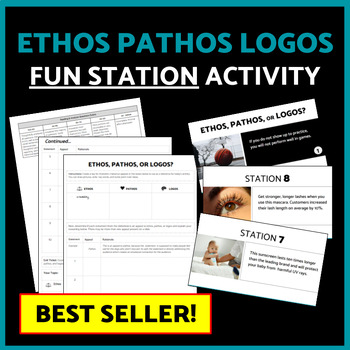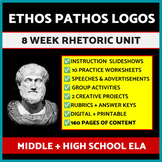Ethos Pathos Logos Fun Activities: STATIONS, Ethos Pathos Logos Worksheet
- Google Drive™ folder

What educators are saying
Also included in
- SAVE 25% OFF with this 8-week Ethos Pathos Logos Mega Bundle. Strengthen your middle and high school student’s rhetorical analysis, argumentation, communication, and persuasive writing skills with a variety of fun and engaging activities that teach argumentative writing. This bundle differs from otPrice $105.28Original Price $141.00Save $35.72
Description
TEACH ETHOS PATHOS LOGOS WITH THIS FUN & ENGAGING STATION ACTIVITY
Students move around the room to 10 different stations to practice their understanding of ethos, pathos, and logos. This ethos pathos logos activity provides students the opportunity to practice identifying if a statement appeals to ethos, pathos, or logos. Once students determine the appeal, they must explain their reasoning. This ethos pathos logos activity includes a printable note-taking guide for students to fill out & print-outs for each station. This activity can be completed in stations or you can project the statements at the front of the classroom: Students practice determining the difference between ethos, pathos, and logos by viewing fun and relatable statements on each slide (or at each station). Students then write the appeal and their rationale within their printed note-guide. At the end of the activity, students create their own example statements for all three appeals to apply what they have learned. Your students will enjoy traveling to each station to fill out their note-taking guide since it gets them up and out of their seats. The setup for this station activity is EASY. Just print one sheet out per each table group. That's it. :)
Teacher instructions: Print out the two-page note-taking guide (double-sided) and hand out to each student. Present this slideshow to your students as they follow along on their note-taking guides. Each slide correlates with a section of the students’ note-taking guide. This portion of the lesson gives students a refresher on what the difference is between ethos, pathos, and logos. It also serves as a cheat sheet for them to use as they move around each station, in case they need reminders. After reviewing ethos, pathos, and logos, then have students complete the station portion of the activity. Place each station printout sheet on each station area (table group) and set a timer for 4 minutes per station.
Options for this lesson: The slideshow allows for discussion within the lesson. There are ten statements within the slideshow. You can have students pause during each of the ten slides and have them discuss which appeal is present and why within their small groups or partners. Then, you can have them share out after. You can also have students pull up the slides on a computer and let them work in groups to complete the lesson if you would like students to be more involved in their learning.
- Stations: There are also 10 printable versions of this slideshow if you would like to print them and create 10 areas of the classroom for students to move to at their own pace or in small groups. (They can go to each station out of order while filling in their guide.
Sub plans: This slideshow can also be left for students an easy subplan. Leave printed copies of the student note-taking guides and push this slideshow out in “View Only” mode to Google Classroom. Students can independently work on this lesson using a computer/Chromebook and their note guide. (This means they would not do this as a station but as an independent assignment.
What Teachers are Saying about this Activity...
⭐⭐⭐⭐⭐ This product makes a teacher's job easier. It is ready to go.
⭐⭐⭐⭐⭐ This resource is very comprehensive and visually appealing. I love having a way to engage my kinetic learners. They were very engaged and enjoyed getting to learn in groups.
⭐⭐⭐⭐⭐ My students loved this resource! I have a variety of learners within my classroom and those who may not always actively participate loved every moment of this activity/process.
⭐⭐⭐⭐⭐ This was really fun to use right out the gate, with the right preparation. My students thoroughly enjoyed stations with Ethos, Pathos, Logos. I would advise making sure you have taught to the material.
⭐⭐⭐⭐⭐ This is a great resource! It engaged and challenged my students while providing opportunities for well-rounded discussion. Thank you!
⭐⭐⭐⭐⭐ I just love using stations in my English classroom to either introduce or reinforce certain concepts. This resource did not disappoint the kids nor myself. I will be using it again this year.
Please let me know how this lesson works in your classroom. :)
Check out my Ethos Pathos Logos Unit Guide / Bundle. This unit guide features ALL of my ethos pathos logos lessons so that you are equipped with EVERYTHING you need to teach a successful ethos pathos logos unit. This bundle is filled with ethos pathos logos worksheets and ethos pathos logos activities to make your students experts at identifying and utilizing Aristotle's rhetorical appeals.






